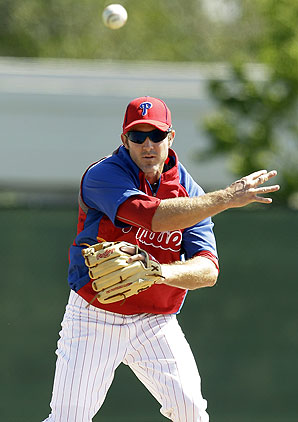
Utley injury highlights cause for concern in Philadelphia
Guess how many second basemen as old as Utley played 130 games at the position last year. That would be one: Chone Figgins, who was awful (84 OPS+). Welcome to baseball in the Testing Era, where the actuarial tables have been rewritten. Ten years ago, in 2001, before testing, six guys 32 and older played 130 games at second base -- that's four years worth of such players in today's game (2007-10).
Utley's ferocious work habits and hard style of play, not to mention plain bad luck, could be catching up to him.
And that's the problem with the Phillies, your presumptive 2011 National League champions. They are an older team: Ryan Howard, 31, Utley, 32, Carlos Ruiz, 32, Jimmy Rollins, 32, Placido Polanco, 35, Raul Ibañez, 38 . . . and now they want to replace Utley with Wilson Valdez, 32, who never batted 350 times in a season?
The fallout from signing Cliff Lee is that the Phillies don't have room to add an established player at significant cost. But that may not be a bad thing for Philadelphia. It is better off finding a young, athletic, defensive-minded second baseman to stand in for Utley if he is out for a lengthy spell -- especially with all the money it has invested in pitching.
Oh, and about that great starting rotation? Do you expect them to make all of their starts? Lee is 32, Roy Oswalt is 33 and Roy Halladay is 33. It is unusual for three guys on the same team age 32 and older to make at least 32 starts.
It's happened only seven times since 1901, only four times without a knuckleball pitcher among the trio, and only once in the past 17 years -- back in 2001 when John Burkett, Tom Glavine and Greg Maddux of the Braves made the 32/32 club without the strain of needing plus-velocity.
The Phillies are still a force to be reckoned with in the National League, but the Utley injury brings their worst-case scenario into play. They look like a great team on paper, but because of age, durability is Philadelphia's concern.
Pedro Martinez is 39 and hasn't pitched since 2009, but he said he is not retired. Martinez, who weighs 195 pounds, said he is working out and throwing in Miami in case "the right team and the right time" add up to another opportunity to pitch in the majors. Martinez said he proved to himself that his arm is in good health by firing stones hard enough and accurate enough to dislodge coconuts from trees. The Marlins would seem to be the most appealing fit for Martinez if only because of the proximity to his home.
If Martinez does not come back, he will go on the Hall of Fame ballot of December 2014. Other first-time eligible players who would join Martinez on that ballot include Randy Johnson, John Smoltz and Gary Sheffield.
In the meantime, whether he comes back or not, Martinez will enter the halls of the Smithsonian. A portrait of Martinez, created in 2000 by Susan Miller-Havens and donated by Peter Gammons, will be installed March 25 at the Smithsonian's National Portrait Gallery. It will be the first portrait of a major league pitcher in the gallery's collection.
Back in 1922, the Pathe Brothers Company of Paris developed 9.5 mm film, an inexpensive format that became popular in Europe. Two years later, somebody took a 9.5 mm film camera to Yankee Stadium, then scarcely more than a year old, and shot film of some of the greatest legends in baseball history, who could have been there taking part in some sort of exhibition game: Babe Ruth, Ty Cobb and Walter Johnson. The film may have been part of an instructional series that was distributed in Europe and then essentially forgotten for nearly a century.
MLB Productions recently acquired three minutes of this rare, high-quality footage. The fascinating up-close look of Ruth and Cobb hitting and Johnson pitching will be shown on MLB Tonight Monday at 7 p.m. on the MLB Network. (Disclosure: I work for MLB Network, though not in 9.5 mm.)
The rare film is captivating because it brings these baseball ghosts closer to life than almost anything else you might have seen: the uncoiling of Ruth's rotational power, which was innovative back then; a clear look at how Cobb awkwardly began his swing with his hands apart and brought them together as his bat came forward; and the unique slingshot style of Johnson, who, with his velocity and arm angle, must have been particularly frightening to righthanded hitters. Watching these greats, you understand how far (and how much better) the mechanics of the game have evolved.
The stars were not far from the top of their game when the film was made in 1924. Johnson, then 36, won the pitching Triple Crown; Ruth, 29, and still five years from wearing his famous number 3, nearly won the hitting Triple Crown; and Cobb, 37, hit .338 with 211 hits, the last of his nine 200-hit seasons.
Still to debut is another rare gem discovered by MLB Productions: film presumably taken at Ebbets Field of the pitching motion of Dazzy Vance -- also from 1924, the year Vance won the NL's pitching Triple Crown and MVP. Until this discovery, no moving images ever were known to exist of the Hall of Fame righthander.




